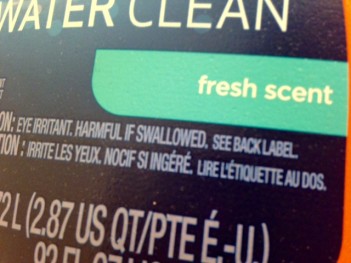Working With and Learning From Nature
“Fragrance” Stinks

For people like me, who don’t like the smell of popular detergents and fabric softeners, it’s getting hard to avoid the stuff. The fragrance of scented laundry is common on city buses, subways, and sidewalks where the odor of these products, much like an overpowering perfume or cologne, can announce a person’s arrival and departure. I’ve smelled them on hotel towels and sheets, thrift store clothing, and once, when I was unlucky enough to live above the washer and dryer of my apartment complex, in my own living room.
But, to experience the full power of these products, you need travel no further than your local laundromat. There the myriad scents of detergents, fabric softeners, and dryer sheets mingle together in a cloying odoriferous cocktail that upon inhalation, triggers my fight or flight response, and helps me understand what people mean when they say they have “allergies.”
After years of silent suffering, I wanted to know what makes the fragrance of these products so strong and, in my case, so irritating to my respiratory system.
To find out, I decided to take a closer look at one of America’s favorite fabric softener dryer sheets. Here are the ingredients:
- Dipalmethyl Hydroxyethylammoinum Methosulfate Fatty Acid- A Softening and Antistatic Agent
- Fatty Acid- Softening Agent
- Polyester Substrate- Carrier
- Clay- Rheology Modifier
- Fragrance

I have no idea what Dipalmethyl Hydroxyethylammoinum Methosulfate Fatty Acid is. Rheology Modifier means thickening agent. The polyester substrate is the little sheet of fabric that goes in your dryer.
But, the ingredient that intrigues and bothers me the most is that beautiful word Fragrance, a mysterious additive found in many consumer products from detergents and shampoos to carpet cleaners and baby wipes. According to the Campaign For Safe Cosmetics, fragrance is considered “a trade secret, so companies don’t have to tell us what’s in it.” Fragrance may contain “often dozens or even hundreds of synthetic chemical compounds.”
Artificially derived fragrances have been shown to cause asthma attacks and allergies. Some fragrances contain neurotoxins, which are toxic to the brain and phthalates, a class of chemicals that has been linked to hormone disruption. An Environmental Working Group Report found that the average fragranced product contains 14 secret chemicals not listed on the label.

A peer-reviewed study funded by The Silent Spring Institute independently tested 213 consumer products for 66 chemicals associated with either endocrine disruption or asthma. The study published in Environmental Health Perspectives found that, “Fragranced products – including air fresheners, dryer sheets, and perfume – and sunscreens had the largest number of target chemicals and some of the highest concentrations.”
Dr. Anne Steinemann, a University of Washington professor, conducted a study to find out what kinds of chemicals are emitted in the air vented by dryers. Clothes were washed with scented laundry detergent and/or dryer sheets. The dryer’s emissions included twenty five volatile organic compounds, of which seven were hazardous air pollutants. Two of the seven are known carcinogens, acetaldehyde and benzene. Another study done by Dr. Steinemann and Dr. Stanley Caress shows that “30.5% of the general population reported scented products on others irritating, 19% reported adverse health effects from air fresheners, and 10.9% reported irritation by scented laundry products vented outside.”
The Environmental Working Group gives many Dryer Sheets a “D or “F” grade because they contain ingredients that may have the potential for “respiratory effects; nervous system effects; skin irritation/allergies/damage” and for ingredients that are damaging to aquatic environments.
The polyester used in these sheets is derived from oil and is not biodegradable. Millions of these disposable pieces of polyester are thrown out daily after a single use.

The makers of these products claim that they give our clothes the “classic smell of line-dried freshness.” Even though these products may contain high concentrations of allergens and toxins, many people still swear by the smell and believe that “It’s the only way I know my clothes are clean.” So, how did corporations convince us that fresh laundry smells like a chemical potpourri?
Laundry alternatives? There’s a lot. Baking soda and white vinegar can effectively remove odors from clothes. If you’re crafty or a DIY’er, make your own reusable dryer sheets. Some people use tennis balls or balls made out of aluminum foil or wool. If you want clothes that smell like they’ve been line-dried, hang them on a clothes line. You can save money and energy by taking advantage of that huge clothes dryer in the sky that doesn’t require any added chemicals to dry your clothes and give them that just-washed scent.
I want to make a stand against these companies to STOP making these awful products. We the consumers need to STOP buying them and demand that they make affordable safe products. Any ideas on how I can be heard and spread the word? I’m starting my own line of household products that are safe and affordable. My main focus will be to educate people of the harmful ingredients. While supplying them with my all natural safe alternatives to buy.
Good for you, Colleen! Safe and affordable home care and household products are definitely needed. I would educate people about this issue and how you are coming up with an alternative. Do you have a blog?
No blog, Do u think that is a good way to reach people?
Yes, it can be. WordPress has blogs that are free and easy to navigate.
Silent Spring was complete garbage science that ended up in the completely unnecessary deaths of millions of African children from Malaria!
Wise up!
Hi Jeff,
Are you referring to the research that I cited from the Silent Spring Institute on fragrance?
Jill